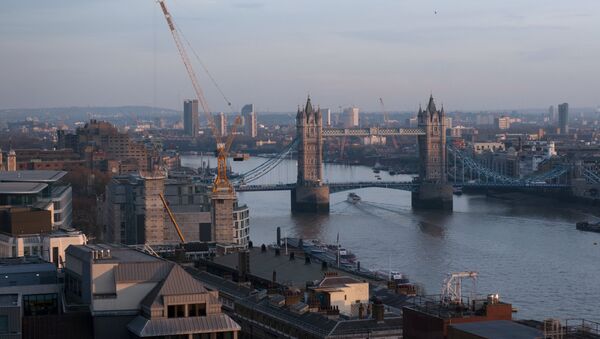Britain was booming in 1989 and on a beautiful summer's evening dozens of affluent young Londoners were enjoying a party on a riverboat, the Marchioness.
Just after 1am tragedy struck as the pleasure cruiser collided with a dredger, the Bowbelle, near Cannon Street railway bridge.
The Bowbelle was a far bigger and heavier vessel and the impact was fatal for the Marchioness, which began to sink within seconds.
Those on the Marchioness, who had been celebrating the 26th birthday of Portuguese banker Antonio de Vasconcellos, were thrown into turmoil.
Fifty-one people would lose their lives that night and the disaster would lead to a criminal trial and far-reaching reforms to the rules for boats on the Thames in central London.
Condolences From France, Australia and Soviet Union
New documents, released by the National Archives, show Britain received condolences from a number of world leaders, including France's President Francois Mitterand, Germany's Chancellor Helmut Kohl, Australian Prime Minister Bob Hawke and the Soviet Union's President Mikhail Gorbachev within hours of the tragedy.
The archives also include a handwritten note from a civil servant in which he responds to Prime Minister Margaret Thatcher's suggestion that Transport Secretary Cecil Parkinson should attend the Marchioness memorial service in September 1989 instead of her to enable her to "make a prompt departure for Japan" where she was due on a state visit.
The memo says Mr. Parkinson "would be out of the country" and suggested the Lord President of the Privy Council, Geoffrey Howe, could represent the government.
The documents also include a letter written in July 1992 to Mr. Parkinson by the Home Secretary Kenneth Clarke.
In it he welcomed the rejection of a recommendation made by the secretary general of the Law Society, John Hayes, that there be an independent review of rescue equipment and arrangements on the Thames.
"The relevant authorities in London…have had over two years to absorb the lessons which can always be learnt from an incident as serious as this, and contingency plans have been adjusted accordingly," wrote Mr. Clarke, who is still a Conservative MP and is one of the foremost opponents of Brexit.
Both Skippers Blamed for Lack of Look-outs
The Marine Accident Investigation Bureau had delivered its own report into the disaster in 1991 — which blamed the look-outs on both boats — and Mr. Clarke claimed there was no need for a full independent inquiry.
"The Government has given careful consideration to this recommendation but has concluded that a further review of this kind would not be justified. Action is, however, being taken to ensure that the lessons learned from the Marchioness/Bowbelle disaster have been fully assimilated," wrote Mr. Clarke.
#OnThisDay in 1989 51 beautiful people lost their lives in the Marchioness disaster. #NeverForgotten 🙏🏼 R.I.P #MarchionessDisaster pic.twitter.com/cO1LauzMvJ
— Leigh Pickett (@Leigh_Pickett) 20 August 2017
But pressure for a public inquiry continued, especially after a 1995 inquest jury returned a verdict of unlawful killing on the victims.
In 1999 the then Deputy Prime Minister John Prescott ordered an inquiry into the circumstances surrounding the "last and worst collision" on the River Thames.
A public inquiry, chaired by Lord Justice Clarke (no relation), into safety on the River Thames and the circumstances surrounding the sinking of the Marchioness was set up and finally reported in 2000.
Lord Justice Clarke made a total of 74 recommendations on Thames safety, most of which were finally introduced by 2003, 14 years after the disaster.
The Marchioness was struck from behind by the Bowbelle and was turned 90 degrees and then flipped over by the impact.
'Like a Bicycle Hit by a Truck'
The Bowbelle's anchor sheared off the roof of the Marchioness, which immediately began taking on water.
One eyewitness who watched from the riverbank described the impact as being "like a bicycle run over by a lorry (truck)".
Those relatively lucky passengers who were thrown into the water clung onto bits of debris or the structure of the bridge.
But many more were trapped in the boat, which was dragged underneath the Bowbelle.
Twenty-four of the dead would be recovered from the hull of the Marchioness, while another 27 drowned or died of their injuries.
Marchioness Skipper Was Among the Dead
The dead includes Mr. de Vasconcellos, his brother Domingos, and Francesca Dallaglio, whose brother Lawrence would later captain the England team which won the Rugby World Cup in 2003.
The skipper of the Marchioness, Stephen Faldo, also lost his life.
The coroner, Dr Paul Knapman, was criticized for ordering the hands of more than 20 victims to be cut off for identification purposes.
In 1991 the skipper of the Bowbelle, Douglas Henderson, was acquitted of failing to maintain a proper lookout after a jury at his retrial failed to reach a verdict.
The following year charges of manslaughter were dropped against the owners of the Bowbelle, South Coast Shipping Company Ltd, and four of its directors.
The Bowbelle, which had by then been renamed the Bom Rei (Good King), sank off Madeira in 1996.


